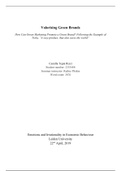Valorising Green Brands
How Can Green Marketing Promote a Green Brand? Following the Example of
Tesla, “A sexy product, that also saves the world”
Camilla Tepin Rizzi
Student number: 2253488
Seminar instructor: Ruthie Pliskin
Word count: 2876
Emotions and Irrationality in Economic Behaviour
Leiden University
22nd April, 2019
, Environmental concerns have been a worldwide issue and ever since the United
Nations Conference on Environment and Development 20 years ago (UNCED, 1992; Valor,
2008), more people became aware about costly effects of consumer culture, triggering
environmental damage, pollution and climate change (Chen & Chai, 2010 in Joshi &
Rahman, 2015). In the early 1990s, consumers became more sensitized to these deleterious
effects, and environmentally-friendly purchases started to trend (Chen, 2010). Green
consumption is key to pro-environmental behaviours, as to minimize the impact consumers’
purchases have on the environment (Nguyen, 2017).
‘Green consumption’ relies on consuming in an environmentally responsible way,
hence employing products and services that are green (Joshi & Rahman, 2015) with the aim
of counteracting or reducing environmental harm (Kim, Yoon & Shin, 2016). Adopting a
sustainable lifestyle progressively mitigates human impact (Bruzzi, 2014), accordingly,
several consumers’ prerogatives gradually shifted towards sustainability. Hereafter, growing
interest towards environmental protection increased demands in green products (Yan &
Yazdanifard, 2014; Joshi & Rahman, 2015) and differentiation of a new green market-area.
Businesses invested in green marketing consistent with “greening demands” (Ottman, 1993 in
Bruzzi, 2014). Green products’ sales are incrementing as eco-friendly attitudes stepped in and
consumers have stated intentions to pay more for green products (Chen, 2012).
Despite the progress and willingness to act “green” – used interchangeably with “eco-
friendly” in this paper - consumers’ purchasing behaviours are not necessarily greener than
beforehand (Miniero, Codini, Bonera, Corvi, & Bertoli, 2014). Green products remain
confined to one to three percent of what the market offers (Moisander, 2007). According to
Young, Hwang, McDonald and Oates (2010), 30% of consumers report environmental
concerns, yet they are not behaviourally consistent with their attitude; besides, numerous
postpone acting “green” (Miniero et al., 2014). As possibly due to “motivational and
practical complexity of green consumption” (Moisander, 2007 p. 404), interest regards
reducing this perceived complexity increasing motivations to buy green.
Great amounts are spent over green advertising which turns out to be ineffective in
creating buying intentions even when their message is accepted (Kim et al. 2016); other times
the difficulty consists of determining which product is the “greenest” on the market (Pickett-
Baker & Ozaki, 2008). Another issue is that consumer culture still devalues “green” products
and repute them as an obstacle to hedonic experience. For instance, consumers are reluctant
1





